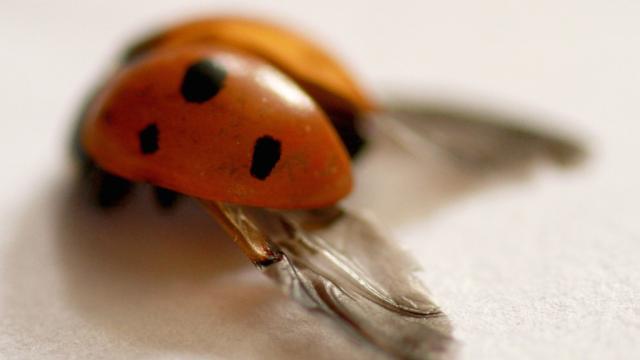The common ladybird is easily recognised by its signature red and black spotted shell. But when researchers at the University of Tokyo used a creative trick to make its carapace transparent, it revealed insect wing secrets that could impact development of robotics, satellite antennas and microscopic medical instruments — perhaps even a re-imagining of the folding mechanism of your umbrella.
Image: Brian Fagan/Flickr Creative Commons
In a paper published this week in Proceedings of the National Academy of Sciences, Kazuya Saito, Assistant Professor at the University of Tokyo’s Institute of Industrial Science, wanted to figure out exactly how the ladybird could fit its wings, which are much longer than the rest of its body, under its distinctive shell. Not just out of sheer curiosity, though.
“My main research purpose is to develop new space deployable structures such as solar array paddles and antenna reflectors, so I’m interested in all insects which have foldable wings,” Saito told Gizmodo in an email. “Compared with other beetles, ladybugs are very good at flying and frequently take off. I thought their wing transformation systems are excellent and have large potential for engineering.”
To further explore that potential, the researchers needed a new view of the collapsed wing, which is normally hidden under the ladybird’s distinctive red and black shell, called the elytra. Saito and his team attempted a number of different techniques to peek past the the ladybird’s elytrons (the two hemispheres of the elytra) to uncover the wings underneath.
“At first, I tried to use a 3D printer for making an artificial wing, but found it was difficult to make a thin elytron with enough transparency,” said Saito. The researchers also used high speed footage to record a ladybird retracting its wings, but that still wasn’t enough.
It was the team’s secretary who recommended they try a UV-cured resin, normally used in nail art, to construct and transplant a clear replacement for the strong but flexible elytron. The researchers actually had to make their nail art elytron by hand, moulding it in a teeny-tiny silicon impression of the shell, before adding it to the beetle. The resin-based elytron was transparent and gave the researchers a window into the ladybird’s mechanics.
What they found was pretty incredible. Using micro computed tomography (a CT scan), they discovered that the wings had bending points that used a similar mechanism as a curved tape measure. Just like a folded tape measure springs open, ladybirds use stored energy found in veins along the surface of the wing to extend them when they take flight.
“Despite the complex transforming function, the wing frame has no joint,” wrote Saito. “Usually, transformable structures require a lot of parts including joints and rigid parts. Ladybugs effectively use flexibility and elastic behaviour in the structures and achieve complex transformation by very simple structures.”
These results could have applications in technologies like foldable wings of micro air vehicles, he said. Saito notes there are many ways to fold a structure into a more compact form, but ladybird wings can “confer high stiffness and strength in an unfolded shape, which can tolerate high frequency wing flapping”.
The researchers couldn’t have figured this out without the transplanted elytra, as the wing-cover plays a huge role how the wings operate. The edge and undersurface of the elytra guide the folding wing into shape during the retraction while the bug is walking around. Saito was surprised that the artificial, transparent shell worked as well as it did.
Saito hopes to keep investigating how small insects fold their wings and translating those findings into engineering solutions for robots and satellites. But he also sees a somewhat more mundane application on the horizon that anyone who’s gotten caught in the rain with a broken umbrella can appreciate.
“Closer to home, umbrellas are also interesting targets,” Saito said, wrapping up his email. “I have no concrete design image, but believe that beetle wing folding has the potential to change the umbrella design that has been basically unchanged for more than 1000 years.”
[PNAS]
